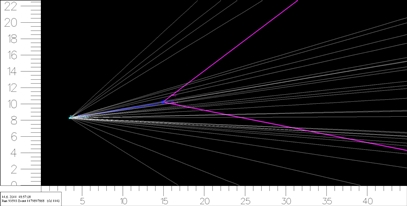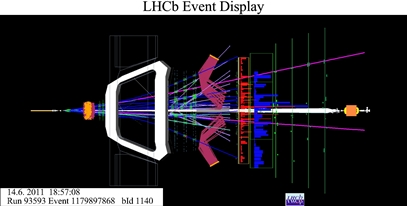[ Branching ratio B0s →μμ < 1.2×10-8 at 90% CL and 1.5×10-8 at 95% CL ]
LHCb physicists continue their search for new physics, see 8 April 2011 news for introduction. They have presented updated results during the International Europhysics Conference on High Energy Physics (EPS-HEP) at Grenoble this week. The LHCb physicists have succeeded in setting the limit for an enhanced decay rate of the strange beauty particle B0s, composed of a beauty antiquark (b) bound with a strange quark s, into a μ+ and μ– pair, as low as about 4 times the rate calculated within the Standard Model (limits 1.2×10-8 at 90% CL and 1.5×10-8 at 95% CL for experts). This result was obtained from the analysis of about 8 times more data than in the previous analysis.

click the image for higher resolution
The computer reconstructed images above show the most significant event compatible with the strange beauty B0s decay into muon pair seen as a pair of purple tracks traversing the whole detector. The right hand image shows a close-up around the proton-proton interaction point from which many tracks originate. The B0s decays about 1 cm from the proton-proton collision point into two muons (purple tracks). The invariant mass of muon pair corresponds to the B0s mass. The number of observed B0s candidates is slightly above the background predictions and compatible with the expected signal predicted by the Standard Model (SM) theory. This analysis is much more sensitive than previous experiments, and although large deviations (by more than a factor 4) from the SM are excluded, there is still plenty of room for new physics contributions. LHCb physicists are expecting to be able to analyse about three times as many events by the end of 2011, and about ten times more by the end of 2012, to give a final answer for the possibility of a new physics contribution to this interesting rare decay.

